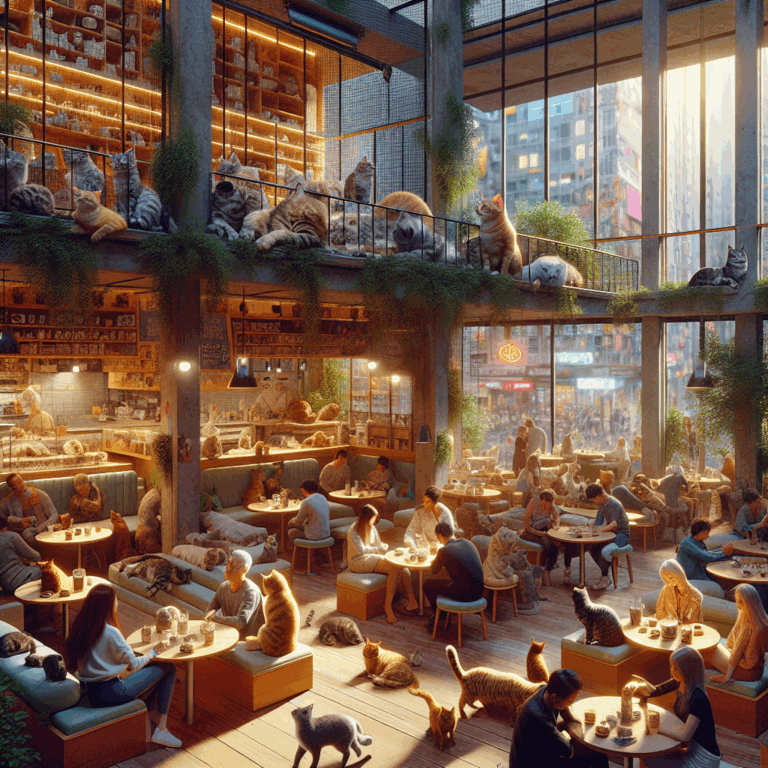The Rise of Cat Cafés: How Feline-Friendly Establishments Are Changing Urban Landscapes
- No Comments
In recent years, a unique trend has been sweeping through urban areas across the globe: the rise of cat cafés. These feline-friendly establishments are not only capturing the hearts of cat enthusiasts but are also transforming social spaces in cities from Tokyo to Toronto. The concept, which originated in Taiwan in the late 1990s and gained immense popularity in Japan, has now expanded to countless locations worldwide, each offering its unique twist on the feline café experience.
The allure of cat cafés lies in their ability to provide a serene escape from the hustle and bustle of city life. Patrons are invited to relax with a cup of coffee or tea while enjoying the company of resident cats who roam freely throughout the space. This blend of café culture and feline companionship offers a therapeutic experience for many visitors, promoting mental wellness and reducing stress. Studies have shown that interacting with animals can lower cortisol levels and elevate mood, making cat cafés an appealing destination for those seeking a respite from their daily routines.
Many cat cafés also serve a dual purpose as adoption centers, partnering with local animal shelters to provide temporary homes for cats in need. This symbiotic relationship not only helps increase adoption rates but also raises awareness about animal welfare issues. Customers have the opportunity to interact with cats available for adoption in a relaxed setting, often leading to higher success rates in finding them forever homes. As a result, these establishments play a crucial role in alleviating the overcrowding in shelters and promoting responsible pet ownership.
The economic impact of cat cafés is another factor contributing to their popularity. They have become tourist attractions in their own right, drawing visitors from near and far who are eager to experience the novelty of sipping a latte while surrounded by playful felines. This influx of visitors often spills over into neighboring businesses, boosting the local economy and creating a vibrant community atmosphere. Furthermore, the rise of cat cafés has spurred a variety of related industries, from artisanal cat treats to bespoke feline furniture, further contributing to economic growth.
However, the rapid expansion of cat cafés has not been without its challenges. Ensuring the well-being of the cats is paramount, and establishments must adhere to stringent health and safety regulations to maintain a healthy environment for both the animals and patrons. This includes regular veterinary care, proper hygiene practices, and providing ample space for the cats to retreat if they become overwhelmed. Potential café owners must navigate these logistical concerns while maintaining a welcoming atmosphere for visitors.
Despite these challenges, the future of cat cafés appears promising. As more people seek out unique, interactive experiences, the appeal of cat cafés is likely to grow. The trend reflects a broader cultural shift towards valuing experiences over material goods, as well as a heightened awareness of mental health and the benefits of animal companionship.
In conclusion, cat cafés represent a fascinating intersection of urban lifestyle, animal welfare, and economic vitality. They offer a sanctuary for both humans and felines, fostering connections that enrich the lives of all involved. As these establishments continue to flourish and evolve, they stand as a testament to the enduring bond between humans and cats, one that is poised to thrive in the heart of our cities.

In recent years, a unique trend has been sweeping through urban areas across the globe: the rise of cat cafés. These feline-friendly establishments are not only capturing the hearts of cat enthusiasts but are also transforming social spaces in cities from Tokyo to Toronto. The concept, which originated in Taiwan in the late 1990s and gained immense popularity in Japan, has now expanded to countless locations worldwide, each offering its unique twist on the feline café experience.
The allure of cat cafés lies in their ability to provide a serene escape from the hustle and bustle of city life. Patrons are invited to relax with a cup of coffee or tea while enjoying the company of resident cats who roam freely throughout the space. This blend of café culture and feline companionship offers a therapeutic experience for many visitors, promoting mental wellness and reducing stress. Studies have shown that interacting with animals can lower cortisol levels and elevate mood, making cat cafés an appealing destination for those seeking a respite from their daily routines.
Many cat cafés also serve a dual purpose as adoption centers, partnering with local animal shelters to provide temporary homes for cats in need. This symbiotic relationship not only helps increase adoption rates but also raises awareness about animal welfare issues. Customers have the opportunity to interact with cats available for adoption in a relaxed setting, often leading to higher success rates in finding them forever homes. As a result, these establishments play a crucial role in alleviating the overcrowding in shelters and promoting responsible pet ownership.
The economic impact of cat cafés is another factor contributing to their popularity. They have become tourist attractions in their own right, drawing visitors from near and far who are eager to experience the novelty of sipping a latte while surrounded by playful felines. This influx of visitors often spills over into neighboring businesses, boosting the local economy and creating a vibrant community atmosphere. Furthermore, the rise of cat cafés has spurred a variety of related industries, from artisanal cat treats to bespoke feline furniture, further contributing to economic growth.
However, the rapid expansion of cat cafés has not been without its challenges. Ensuring the well-being of the cats is paramount, and establishments must adhere to stringent health and safety regulations to maintain a healthy environment for both the animals and patrons. This includes regular veterinary care, proper hygiene practices, and providing ample space for the cats to retreat if they become overwhelmed. Potential café owners must navigate these logistical concerns while maintaining a welcoming atmosphere for visitors.
Despite these challenges, the future of cat cafés appears promising. As more people seek out unique, interactive experiences, the appeal of cat cafés is likely to grow. The trend reflects a broader cultural shift towards valuing experiences over material goods, as well as a heightened awareness of mental health and the benefits of animal companionship.
In conclusion, cat cafés represent a fascinating intersection of urban lifestyle, animal welfare, and economic vitality. They offer a sanctuary for both humans and felines, fostering connections that enrich the lives of all involved. As these establishments continue to flourish and evolve, they stand as a testament to the enduring bond between humans and cats, one that is poised to thrive in the heart of our cities.


